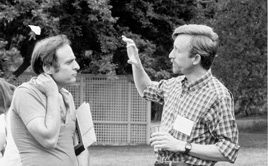|
XLVI: Organization of the Cytoplasm 1981 |
|
|

|
From left: Dr. Lewis Tilney, Dr. Thomas Pollard SYMPOSIUM SYNOPSIS LIST OF PARTICIPANTS CONTENTS OF SYMPOSIUM VOLUME PHOTOGRAPHS PUBLISHED VOLUME  |
Organization of the Cytoplasm
May 27 - June 3, 1981
Symposium Synopsis
Organizer: James Watson,Gunter Albrecht-Buehler
Advisors: Gunter Blobel, Daniel Branton, Bill Brinkley, Werner Franke, Howard Green, Robert Goldman, Marc Kirschner, Keith Porter, Peter Satir, John Singer, Frank Solomon, Klaus Weber and Wolfarth-Bottermann
It is all too easy to take laboratory instruments for granted. They sit on the bench or on the floor, dutifully waiting to be put to work. Yet the whole scientific enterprise could not exist without these metal, glass and plastic servants. Occasionally, a specific piece of equipment becomes well-known–the Waring Blendor–and sometimes a brand achieves the same status–there is a generation of molecular biologists that thrills to the word “Spinco”. The microscope in it modern form has been with us for over 100 years, and is so associated with biology that it is an icon for science as a whole. And yet, with modifications–phase contrast, immunofluorescence, interference contrast and, most recently, confocal microscopy–it continues to be a key tool for thousands of biologists.
This Symposium is a tribute to the power of the microscope, primarily the light microscope. In some ways it hearkens back to the early days of the Symposia when biophysics was a common theme. A glance at the figures shows that this topic integrated microscopical, biophysical and biochemical techniques to investigate cell structure. There were papers deducing structure form the diffusion of macromolecules in the cytoplasm (30 years earlier Francis Crick had used fragments of hematite) while almost every paper had acrylamide gels of contractile and structural proteins. But the Symposium went beyond the structure of the cytoplasm to encompass the cell surface and its interactions with the cytoskeleton, the nucleus and cell functions such as axonal flow that depend on cytoskeletal elements. It was, as Bill Brinkley wrote in the summary, “...the first major symposium in the 20th century to embrace the topic of the cytoplasm as a holistic entity.”
One technique that caught Brinkley’s eye was “video-enhanced-contrast-differential-interference-contrast”, (or AVEC-DIC for short) from R. D. Allen et al. Brinkley recognized how powerful this would be if it could be coupled with using fluorescent markers in living cells. It was just four years later that Brinkley’s wish came true and confocal microscopy was applied to living cells.
Search images: